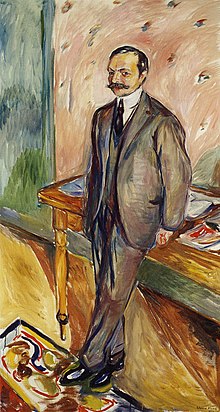Wilhelm Wartmann
Jakob Wilhelm Wartmann (born July 20, 1882 in St. Gallen ; † July 28, 1970 in Zurich ) was a Swiss art historian . From 1909 to 1949 he headed the Kunsthaus Zürich .
Life
Wilhelm Wartmann was born in 1882 to the historian Hermann Wartmann (1835–1929) and his wife Louise, née Hochreutiner. He grew up in St. Gallen, where he attended high school at the canton school on Burggraben . He then studied from 1902 Classical Philology and History at the University of Zurich . He then continued his studies at the University of Paris and received his doctorate with the thesis Les vitraux suisses au Musée du Louvre on Swiss stained glass in the Louvre .
Wartmann came to the Kunsthaus Zürich in 1909, the building of which was opened the following year based on a design by the architect Karl Moser . He initially headed the house as first secretary of the Zurich Art Society , and from 1925 he was director of the museum. Since the Kunsthaus initially had only a small collection, Waldmann initially concentrated on Swiss art and, in addition to contemporary works, acquired works of late Gothic painting and paintings by Johann Heinrich Füssli . One of the important exhibitions of the first decade in 1917 was the large retrospective with pictures by Ferdinand Hodler . In the same year, Wartmann was one of the founders of the Vereinigung Zürcher Kunstfreunde , which continues to support the Kunsthaus with acquisitions to this day. In 1920 the collection of Hans Schuler came to the Kunsthaus as a legacy. With paintings by Pierre-Auguste Renoir , Paul Cézanne , Vincent van Gogh and Pierre Bonnard , works of French Impressionism and Late Impressionism could be shown for the first time . In 1922, Wartmann organized an exhibition with pictures by the Norwegian Edvard Munch . The largest Munch collection outside of Scandinavia was subsequently created in the Kunsthaus, including Munch's portrait of Dr. Wilhelm Wartmann belongs. In addition to works by Munch, Wartmann also acquired paintings from other Expressionist painters . In this way he was able to assemble important groups of works by artists such as Lovis Corinth , Oskar Kokoschka and Ferdinand Hodler.
During Wartmann's tenure in 1925, the extension building was opened according to plans by Karl Moser, with which the Kunsthaus had considerably larger exhibition space. He was particularly committed to the work of Félix Vallotton , to whom he dedicated exhibitions in 1928 and 1938. He also managed to buy several works by the artist. In 1929 he showed current artistic currents of surrealism in the exhibition Abstract and Surrealist Painting and Sculpture . Wartmann dedicated the first comprehensive retrospective outside of France to Pablo Picasso in 1932. Shows on the work of Fernand Léger and Juan Gris followed in 1933 . From 1939 to 1944, Wartmann was a member of the Federal Art Commission . Shortly before the end of his term in office, in 1949 he succeeded in integrating Leopold Ružička's art collection into the Kunsthaus Zürich, adding Dutch works from the 17th century to the collection. His writings include numerous articles on art history, most of which he published in the monthly Das Kunsthaus , which he edited . In 1950 René Wehrli took over the position of director as his successor. Wartmann was married to Anna Hedwig Ruch (1900–1980) and had two daughters. He died in Zurich in 1970.
literature
- Walter Kern: On the resignation of Director Dr. Wilhelm Wartmann. In: Swiss Monthly for Architecture, Art and the Artistic Trade, No. 37, Association of Swiss Architects, Winterthur 1950.
Web links
- Anna Katharina Bähler: Wartmann, Jakob Wilhelm. In: Historical Lexicon of Switzerland .
- Wilhelm Wartmann In: German National Library
- Wartmann, Jakob Wilhelm In: Matriculation edition of the University of Zurich
Individual evidence
- ↑ Wilhelm Wartmann in memory. Article in the Neue Zürcher Zeitung on August 4, 1970.
- ^ Memorial service for Wilhelm Wartmann. Article in the Neue Zürcher Zeitung on July 31, 1970.
| personal data | |
|---|---|
| SURNAME | Wartmann, Wilhelm |
| ALTERNATIVE NAMES | Wartmann, Jakob Wilhelm (full name) |
| BRIEF DESCRIPTION | Swiss art historian and museum director |
| DATE OF BIRTH | July 20, 1882 |
| PLACE OF BIRTH | St. Gallen |
| DATE OF DEATH | July 28, 1970 |
| Place of death | Zurich |
